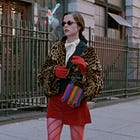Life in plastic, it's fantastic
The beauty vibe shift, facelifts, aesthetic homogeneity, and self-commodification
Find Nicstalgia on Substack? Welcome to your new favorite destination for deep conversations about superficial things! If you’re not already subscribed, please do so. Subscribers, thank you! Shoutout to the wonderful Emily for upgrading to paid!! 💖
Feel free to share this post with your cool sister, the girls from your dance class, your best friend from high school, that ex-coworker you still get drinks with sometimes, your book club, and your group chat where you’re talking about the Britney x Balenciaga collab, Ashlee Simpson’s Vegas concerts, Tyson Ritter’s OnlyFans, and Josh Schwartz & Stephanie Savage’s new show about Barney’s NY.
^^ If you can’t tell from these references, this newsletter was originally gonna go out last week, but I needed a little break! (My first in 82 consecutive weeks!) Since then, countless new articles have been written about the beauty vibe shift that’s currently happening. Regardless, I always consider Barbie’s Dolls of The World collection to be a relevant topic of conversation.
Plastic surgery has been stigmatized, normalized, and commodified, sometimes all at once. There are many sociopolitical factors that explain why, but lately, cosmetic procedures have been quite the hot topic.1 Under patriarchy and capitalism, women will always be sold an inhuman, unnatural beauty ideal. One thing the beauty industry (or any female-focused industry) will never do is stop weaponizing, profiting from, and perpetuating your insecurities. Why redefine what beauty means and actually make the world a more equitable, accepting place for women when so many people are gazillionaires because you hate yourself? Another problem here is that farcical beauty ideals actually are attainable, at least by very rich people, and public opinion about getting work done is skewing positive.
I consider there to be three drivers that fuel the cosmetic surgery industry’s lucrative business: speculation, scrutiny, and praise. Lorry Hill’s speculative-but-nice “What did they [probably/allegedly/likely] get” videos are wildly popular.2 Surgeons have built up massive social media followings because they speculate about celebrity treatments under the guise of being an industry insider. MedSpa employees are also content creators, hoping to capitalize off of TikTok virality. The public can speculate and scrutinize all they want about celebrities’ plastic surgery (and they do). The only antidote to criticism, and the gatekeeper of praise, is transparency. As of last week, Kylie Jenner is being hailed as a “girl’s girl” because she commented details of her breast implants on someone’s TikTok. Apparently, this newfound transparency was more so inspired by the love of her life, “Lil Timmy Tim”, rather than her mother Kris, who had a previous facelift of hers – performed by the same doctor who did Kylie’s implants – televised on Keeping Up With The Kardashians in 2011.3 This doctor is clearly talented, but I’m not sure Kris will truly be happy unless there’s a medical advancement that allows her to actually skin and wear her daughter Kim’s face.
The Kardashians have shaped beauty standards for most of the 21st century, but people have been getting surgery to look like Barbie, a toy with outrageous, unrealistic body proportions, for generations. Going under the knife countless times to meet this oddly specific standard has been universally recognized as delusional, dangerous, and subject to public mockery. But with the normalization of GLP-1s by people without a medical need for them and the celebration of deep plane facelifts for women of all ages – combined with a sincerely disappointing degradation of any sort of collective media literacy and an unsettling political climate – there’s been a shift in sentiment around body modification. Procedural advancements now make people look “good” and “snatched” rather than “botched”, more like an optimized version of themselves than a Barbie.
Women are “empowered” to spend exorbitant amounts of money to become taut, poreless, and ageless, but if they’re becoming “themselves,” why do they all end up looking the same? Instagram Face, Pillow Face, and Ozempic Face are among the names, used pejoratively, to describe side effects of achieving a particular aesthetic norm. Pillow Face is out, and a new, aspirational vision of what a ‘perfect’ face looks like is in. Even if a procedure was non-invasive or done by a highly-skilled doctor, it seems like every day, a different celebrity hits the scene with an uncanny, new face. Lindsay Lohan, Christina Aguilera, Kris Jenner, Donatella Versace, Anne Hathaway, et al. now present as hyperreal versions of themselves. In the YouTube video, Why Everyone Looks the Same Now: The Death of Unique Beauty, Laura Jane Atelier talks about how globalization, consumerism, and social media all aided in producing a homogenous beauty standard. A single, universal aesthetic can be more efficiently marketed and sold to a global audience. Unfortunately, as a result, diverse and rich regional and cultural beauty traditions are lost. Today’s aesthetic sameness and commodification of the face reminds me of Mattel’s commodification of ethnicity during a time of rapid globalization. Celebrities are essentially Barbie’s Dolls of the World® (DOTW) collection come to life! The Dolls of the World collection, one that’s near and dear to my heart, is emblematic of how global politics and consumerism distilled ethnic identity into a perfect, shiny facade of sameness.
The last decade of the 20th century was a critical turning point in cultural, political, and consumer globalization. Girls were wearing Hairagami and chopsticks in their hair, white boys had dreadlocks and wore Baja jackets, and people were getting tattoos of tribal designs and Chinese characters they vaguely understood. Vogue’s Geisha Girls article (1999) claimed that, “There may be an Asian economic crisis, but fashionwise, Eastern dress rules.”4 Multiculturalism aided corporate globalization and pushed an egregiously capitalist agenda: everyone is “empowered” to be a consumer demographic, regardless of gender, race, place of origin, etc.5 Of course, with Baby Boomers becoming parents during “the long economic boom”, Millennial children were a very valuable marketing segment. Who could possibly resist the undeniable allure of K·B Toys, Toys R Us, and The Disney Store? Not me. I had a lot of toys as a kid, including the majority of the DOTW Barbies manufactured between 1995–2000. These dolls were gorgeous, each adorned in traditional, customary dress representative of their culture. I would essentially host a United Nations General Assembly with my Barbies, arranging German, Native American, Polynesian, Ghanaian, Indian, Japanese, Mexican, Norwegian, Arctic, French, Puerto Rican, Russian, Chilean, Polish, Thai, Austrian, Moroccan, Peruvian, and Swedish Barbies in a large friendship circle. Playing with them was so fun! It was like a 6-year-old’s crash course in cultural semiotics. (I also give DOTW credit for sparking my passion for global geography from a young age.6)
I am so fascinated by Barbie face molds’ versatility, especially for the DOTW collection.7 There are three Italian DOTW in total, all with starkly contrasting appearances. While, of course, the appearance of people from any given country is not a monolith, Mattel still had to sell one. Ironically, I did not have an Italian Barbie; to me, “Italian Barbies” were the Tanya dolls my Grandpa got me from Italy. The first Italian Barbie in 1980 used the face mold from the flop 1979 Guardian Goddesses collection because there were no “international” face molds at the time. This original Italian Barbie is tan-skinned, whereas the next Italian Barbie (1993) used the new Teresa face mold (1990) with a visibly lighter skin tone.8 The original Teresa face mold (1982) was designed for Mexican, Spanish, and Brazilian Barbies, but by 1990, Teresa was vague, overarching representation for anyone with brown hair, including Italian, Indian, Puerto Rican, and Native American Barbies. Out of the several Native American DOTW, some also used the Diva/Midge face mold (1985). The Kira face mold (1981) was created to represent dolls from Asia and the Arctic, though the original names of both dolls are now considered outdated and culturally insensitive. The first Barbie with Black facial features was released in 1980. However, Nigerian, Jamaican, and Moroccan DOTW used the Christie face mold (1987), which Black journalist Lisa Jones described in the The Village Voice in 1991 as “brown plastic poured into blond Barbie’s mold.” Ghanian Barbie (1996) is the only DOTW that uses a face mold (Shani, 1990) specifically designed for African American dolls.9
Consumerism, the tourism economy, and exoticism of foreign culture made these special edition collectible dolls highly marketable to largely white, American audiences. The DOTW line served as a soft power vehicle for globalization, introducing young American consumers to an increasingly interconnected world. The Barbies familiarized children a broad idea of global diversity at a time when economic and political forces were shaping an era of international exchange. In addition to teaching children about global culture, geography, traditions, and customs, multicultural dolls can also serve as representation for underrepresented racial and ethnic groups in America. It means a lot to a little girl to play with a doll that looks like her. In the 90s, there were many toy options, though not many were diverse aesthetically. Critics say DOTW flattens rich cultures, perpetuates stereotypes, and collapses context, reducing deep customs into aesthetic shorthand. That is certainly true, but world peace nor nuance is ever the goal in creating a product specifically designed for mass consumption.
The DOTW collection reflects a now-familiar tension: the desire to have global appeal while being smoothened and softened into sameness. Barbie face molds, though subtly varied, still operate within a narrow aesthetic framework. You could say the same thing about societal beauty standards today. Mattel once offered a curated collection of national identities within one plastic prototype, not unlike how we cycle through carousels of filtered, altered, enhanced faces on Instagram. Whether it’s a doll or a celebrity, the message stays the same: visibility, admiration, beauty, and acceptance require conformity. Both the Dolls of the World (Barbies) and the dolls of the world (Kardashian klan worshippers) are aspirational representations of aesthetic homogeny. The faces may change, but the unrelenting desire to fit into a mold remains the same.
Huge thank you to the people who go above and beyond to support my work: Janine, Marie, Liv, CY, Chet, Jack, Matthew P., Matthew M., and Emily! À la Jessica Simpson, I’m gonna love you forever 💐💐💐 If you enjoy Nicstalgia, please consider supporting the most fun newsletter about offbeat, obscure, and niche pop culture.
Newsletter ☆ Instagram ⟡ Website ♡ Podcast Archive ☆ Fitness Schedule ⟡ Physical Media Renaissance™ Zine
I’m so used to writing Hot Topic not hot topic lmao.
My guilty pleasure videos. I want to look away and I can’t. I blame growing up in 2000s tabloid culture.
The relationship between Kylie Jenner and Timothée Chalamet is sooooo unserious.
Although multicultural aesthetics were not seen as cultural appropriation in the 90s, many cases would be considered so now. Could not be less surprised that D&G was at the forefront of this trend. The fashion industry often straddles the very fine line of ‘in good faith’ and ‘in bad taste’.
You will not beat me at Sporcle’s The Countries of the World Map; I’ve been practicing for 15 years…
I’m obsessed with videos where someone removes the original hair and makeup from a Barbie (especially a botched celebrity edition that looks nothing like the person), rethreads its hair, and redoes its makeup with stunning precision.
The yassified 2009 Italian Barbie uses the Lara face mold, which was introduced in 1998 for the Generation Girls (!!!!!) collection. Lara is also the glamorous mold used for Donatella Versace, Cynthia Rowley, Anna Sui, and Diane Von Furstenberg Barbies.
The Shani mold was also used for Michelle Williams from Destiny’s Child’s doll. Kelly Rowland’s doll has an Asha sculpt, and Beyoncé got her own custom sculpt, because of course she did. Production of the Destiny’s Child Barbies (2005) was overseen by Beyoncé’s father, Matthew Knowles, because of course it was.














Yet again, you unlocked a memory from my 90s Barbie-loving childhood that I forgot I even had!!